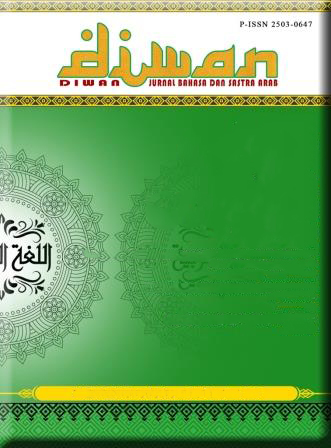Michael Riffaterre's Semiotic Analysis of the Poem 'Ila Ummi' by Mahmoud Darwish
Abstract
يهدف هذا البحث إلى دراسة القصيدة إلى أمي لمحمود درويش باستخدام نظرية سيميائية لريفاتير. درويش من أحد الشعراء ولد في فلسطين. وقصيدته إلى أمي تحكي عن حنينه لأمه. كلمة الأم في هذه القصيدة يمكن أن نفسرها بالأم البيولوجية التي ولدته والأم باعتبارها المكان الذي نشأ فيه أي وطنه. وهذان المعنيان المحتملان نفسرها من خلفية كتابة القصيدة. ولإثبات هذه الفرضية سيتم فحص القصيدة باستخدام النظرية السيميائية لريفاتير. يستخدم هذا البحث أساليب البحث المكتبي مع تحليل البيانات باستخدام تقنيات الوصفية النوعية. فإن سيميائية لريفاتير تبحث أيضًا عن الهيبوغرامات (Hipogram)، فهي مناسبة لتفسير القصيدة. وتظهر نتائج البحث أن هذه القصيدة هي في الأساس تعبير عن الحزن والشوق والاكتئاب. ويوصف هذا التعبير بأنه حنينه إلى أمه البيولوجية، والتي يمكن تفسيرها أيضاً على أنها وطنه، مدينة ميلاده، أي فلسطين. وفي نفس الوقت فإن نقش هذه القصيدة عندما عاش محمود درويش عام 1965 في أحد السجون في إسرائيل وهيبروغرام من هذه القصيدة هي قصيدة أمي لعبد الله البردوني.
Abstract
This article explores the poem "Ila Ummi" by Mahmoud Darwish through the lens of Riffaterre's semiotic theory. Darwish, a prominent Palestinian poet, penned this poem expressing his deep longing for his mother. The word "mother" in the poem carries a twofold significance: it refers both to the biological mother who gave birth to him and to the symbolic motherland, Palestine, the place where he was nurtured. This dual interpretation is informed by the socio-historical context surrounding the poem's creation. To substantiate this hypothesis, the poem is analyzed using Riffaterre's semiotic framework. The research methodology employs a desk research approach, with data analysis utilizing qualitative descriptive techniques. Riffaterre's semiotics also seeks to identify hypograms, hidden textual patterns, which enrich the interpretation of the poem. The research findings reveal that the poem serves as a poignant expression of sadness, longing, and profound grief. This sentiment is rooted in Darwish's yearning for his biological mother, which simultaneously echoes his longing for his homeland, Palestine, specifically the city of his birth. It is noteworthy that the poem was written in 1965 while Darwish was imprisoned in Israel, adding a layer of subtext to its emotional resonance. Furthermore, the hypogram identified within the poem is "My Mother" by Abdullah Al-Baradouni, hinting at intertextual influences and shared themes of maternal and patriotic longing.
Downloads
References
Al-Bardouni, Abdullah. Al’a’mal al-Syi’riyah. Yaman: Hai’ah Al-‘ammah lil Kitab Shun’a, 2002.
Bisaraguna Akastangga, M. Analisis Semiotika Pierce Dalam Puisi “الدنيا“ Karya Mahmud Al-Warraq, PENAOQ: Jurnal Sastra, Budaya Dan Pariwisata, Vol. 2, No. 1, 2021.
Bisaraguna Akastangga, M. Syair al-Hikmah wa al-Mauidzoh Fi Diwan Mahmud al-Warraq (Analisis Semiotika Riffaterre), PENAOQ: Jurnal Sastra, Budaya Dan Pariwisata, Vol. 1, No. 1, 2020.
Bogdon, Robert C. Riset Kualitatif Untuk pendidikan: Pengantar Teori dan Metode. Jakarta: Ditjen Dikti Depdikbud, 1990.
Darwish, Ahmad. Hikayah Aghniyah Ila Ummi, Al-Jazeera Documenter, https://www.youtube.com/watch?v=JpCrgiXBp9I&t=76s. (10 Juni 2023).
Darwish, M. Al-diwan. Beirut-Lebanon: Ried El-Rayyes Books S.A.R.I, 2005.
Haikal, Ahmad. Israeli Responses to Hebrew Translations Of Darwish’s Poetry, Alif: Journal of comparative poetics, Vol.1 2018
Hamzah, Mukhotob dan Muhammad Barrunnawa, Representasi Keresahan Mahmoud Darwish Dalam Puisi Al-Sijn. Kajian Semiotika Riffaterre, Jurnal Al-Ma’rifah, Vol.1, 2021.
Hasibuan, Sammad. Puisi Hanīn karya Faruq Juwaidah (Analisis Semiotika Riffaterre), Diwan: Jurnal Bahasa Dan Sastra Arab, Vol. 7, No. 1, 2021.ikhwn
Lantowa, Jafar. Semiotika, Teori, Metode, dan penerapannya dalam Penelitian sastra. Yogyakarta: Cv Budi Utama, 2017.
Latifi, Yulia Nasrul. Puisi Anā karya Nazik Al- Malaikah analisis semiotika Riffaterre, Jurnal Adabiyyat, Vol. XII, 2013.
Nurgiyantoro, Burhan. Penilaian Pengajaran Bahasa dan Sastra. Yogyakarta: BPFE, 2009.
Pradopo, Rachmaat Djoko. Pengkajian Puisi. Yogyakarta: Gajah Mada University press, 2005.
Pradopo, Rachmaat Djoko. Beberapa Teori Sastra, Metode kritik, dan penerapannya. Yogyakarta: Pustaka Pelajar, 2003.
Ratih, Rina. Teori dan aplikasi semiotik Michael Riffaterre. Yogyakarta: Pustaka Pelajar, 2016.
Riffaterre, Michael. Semiotics of Poetry. Bloomington-London: Indiana University Press, 1978.
Sangidu. Penelitian Sastra: Pendekatan, Teori, Metode, Teknik, dan Kiat. Yogyakarta: Seksi Penerbitan Sastra Asia Barat Fakultas Ilmu Budaya UGM, 2005.
Santosa, Puji. Metodologi Penelitian Sastra Paradigma, Proposal, Pelaporan, dan Penerapan. Yogyakarta: Azzagrafika, 2015.
Ulfa, Hidayatun. Hermeneutik Puisi Bitaqah Huwiyyah dalam antalogi Auraquz Zaitun karya Mahmoud Darwish. Jurnal Diwan, Vol. 6, 2020.
Zaimar, Okke KS. Semiotik: Kumpulan Makalah Seminar. Depok: Pusat Penelitian Kemasyarakatan dan Budaya Lembaga Penelitian Universitas Indonesia, 2000.













